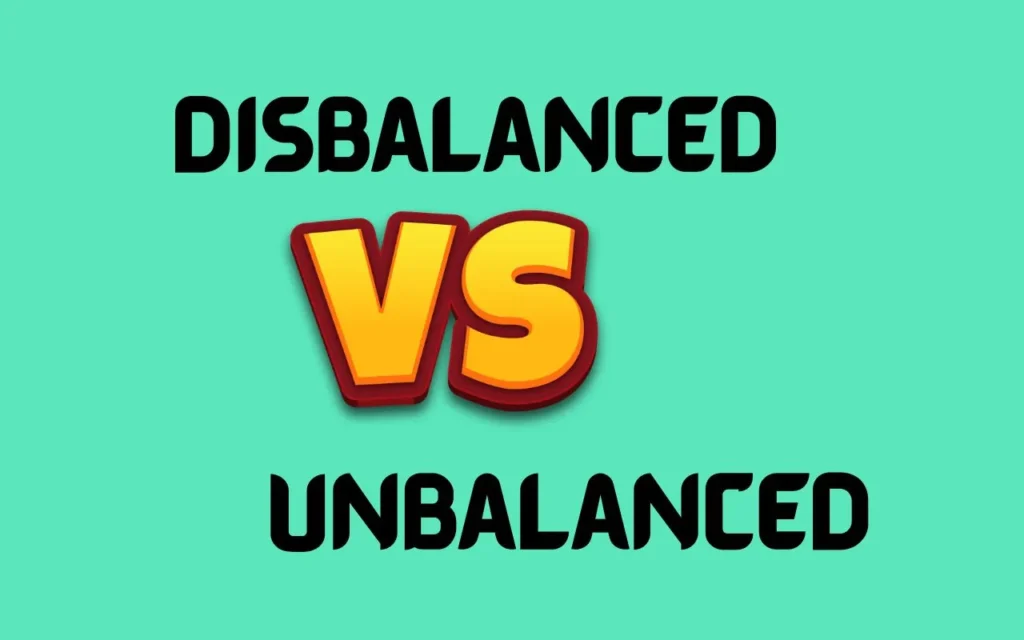Have you ever paused mid-sentence wondering whether to say imbalanced, unbalanced, or disbalanced? You’re not alone.
These terms may seem interchangeable, but they carry subtle—yet important—differences in meaning, tone, and usage. Some are far more common and widely accepted, while others raise a few linguistic eyebrows.
In this guide, we’ll unpack the differences, trace their origins, and look at how each is used in real-world contexts. Plus, we’ll dive into how prefixes like im-, un-, and dis- shape meaning in English.
Let’s get into it and settle this once and for all.
“Imbalanced” is used in formal and technical contexts to describe a lack of proportion or symmetry. “Unbalanced” leans more toward instability or irregularity in everyday language. “Disbalanced” is rare and often considered nonstandard.
Understanding Imbalance in Language: Definitions and Usage
The idea of imbalance comes from the root word balance, which refers to a state of equilibrium or stability. When something lacks that balance—whether physically, mentally, emotionally, or structurally—we say it’s not balanced.
But here’s where things get tricky: English gives us multiple negative prefixes, and not all of them function the same way.
- Imbalanced generally describes something that lacks proper proportions or symmetry.
- Unbalanced often leans toward describing instability or erratic conditions.
- Disbalanced is rarely used and often flagged as incorrect or nonstandard.
Here’s a quick comparison table to give you a snapshot:
| Term | Common Usage | Part of Speech | Typical Contexts |
|---|---|---|---|
| Imbalanced | Formal and technical | Adjective | Psychology, health, society |
| Unbalanced | Conversational | Adjective | Emotions, behavior, structure |
| Disbalanced | Rare, nonstandard | Adjective | Occasionally in niche writing |
An Overview of “Imbalanced”, “Unbalanced”, and “Disbalanced”
These three terms all attempt to express a lack of balance, but the way they do it—and how often we see them—differs.
Imbalanced
Used in professional, clinical, or academic contexts. You’re more likely to hear this term in reports, articles, and diagnostics.
- Example: “An imbalanced diet can lead to nutritional deficiencies.”
Unbalanced
This one feels more personal or colloquial. It’s used to describe mental states, structural problems, and anything that feels off-kilter.
- Example: “After losing his job, he seemed emotionally unbalanced.”
Disbalanced
Although technically understandable, this variant isn’t widely accepted in modern English. It appears in non-native usage or in niche or outdated texts.
- Example: “The disbalanced scale tilted to one side.” (less preferred)
Note: Most style guides and dictionaries consider disbalanced incorrect or archaic.
How Prefixes Affect Meaning in English Vocabulary
English loves its prefixes. But they aren’t interchangeable. Each prefix adds a different flavor to the root word:
| Prefix | Meaning | Common Usage Example |
|---|---|---|
| un- | Not / Opposite of | Unfair, untrue |
| im- | Not / Without | Impossible, immature |
| dis- | Apart / Reverse | Disconnect, disagree |
So why imbalanced and unbalanced but not disbalanced?
- “Unbalanced” is logical—it simply means not balanced.
- “Imbalanced” conveys a lack or deficiency in balance, especially in composition or systems.
- “Disbalanced” seems like it should mean disrupted balance, but it’s not idiomatic in modern English.
That’s why disbalanced remains on the fringe.
Historical Usage Trends of Imbalance Terms in Literature
Let’s take a peek at how these words have been used over time. Thanks to Google Books Ngram Viewer, we can see their relative popularity.
📈 Google Ngram Insights
| Word | First Major Use | Peak Usage Period | Current Trend |
|---|---|---|---|
| Imbalanced | ~1950s | 1980s–2000s | Steady |
| Unbalanced | ~1800s | 1900s | Still widely used |
| Disbalanced | Scarcely used | Never peaked | Near-zero usage |
Observation:
Unbalanced has a longer history, but imbalanced gained traction in technical fields over the past few decades. Disbalanced remains obscure.
Examples of “Imbalanced” in Various Contexts
Let’s explore how imbalanced fits into modern communication. This word shines in formal, clinical, and diagnostic contexts:
🔬 In Science and Health
- “An imbalanced hormone level can affect your mood and energy.”
- “This imbalanced dataset skews the machine learning results.”
🌍 In Society and Economics
- “The imbalanced power dynamics in the workplace caused tension.”
- “An imbalanced trade agreement may harm local industries.”
🧠 In Psychology
- “Therapists may address imbalanced emotional responses caused by trauma.”
Summary:
Use imbalanced when you want to describe a lack of symmetry, proportion, or equity, especially in serious or academic discussions.
Delving into the Meaning and Use of “Unbalanced”
Unlike imbalanced, the word unbalanced often feels more dynamic—or even unstable. It’s commonly used to describe mental, emotional, or structural instability.
⚙️ Physical or Structural
- “The unbalanced load caused the washing machine to shake violently.”
- “The bridge collapsed due to an unbalanced foundation.”
😟 Emotional or Psychological
- “She became unbalanced after the loss of her loved one.”
- “His unbalanced behavior raised concerns.”
🗣️ In Arguments or Viewpoints
- “The article presented an unbalanced view of the political situation.”
Tip:
Use unbalanced when the issue is more about instability or irregularity, rather than a measurable inequality.
Verbal Illustrations of “Unbalanced” in Everyday Speech
To understand how unbalanced is used in everyday language, check out these conversational examples:
- “Don’t walk on that! It’s unbalanced and might tip over.”
- “He went a little unbalanced after the breakup.”
- “That opinion seems totally unbalanced. You need both sides.”
These examples show how common unbalanced is in informal speech. It communicates instability in a relatable way.
“Disbalanced”: A Rare Variant in the Balance Lexicon
Let’s address the outlier: disbalanced. While it technically could make sense—just like disagree or disassemble—it’s almost never used by native speakers or major publications.
Why Isn’t It Accepted?
- It doesn’t appear in most major dictionaries like Merriam-Webster or Oxford.
- It feels awkward and unidiomatic to native English speakers.
- It lacks historical and literary backing.
Where Might You See It?
- Occasionally in non-native writing
- Translations or technical texts where “disbalance” was rendered literally
- Rare online forums or scientific articles (usually with corrections)
Bottom line:
Stick to imbalanced or unbalanced—disbalanced is rarely, if ever, the right choice.
Special Cases: Dietary and Data Specifics
Let’s look at situations where people often mix these terms up.
🥗 Dietary Language
| Correct | Incorrect |
|---|---|
| “An imbalanced diet leads to health issues.” | “An unbalanced diet…” (still acceptable, but less precise) |
| “Too many processed foods create nutritional imbalance.” | “Disbalanced nutrients…” (awkward usage) |
While both imbalanced and unbalanced are used for food, imbalanced is preferred in health-related writing.
💾 Data Science and AI
In technical fields like machine learning, imbalanced is standard.
- “An imbalanced dataset has more negative than positive cases.”
- “Unbalanced data can skew results” – less common phrasing, but still understood.
Pro Tip:
When writing for scientific or technical audiences, use imbalanced to sound accurate and professional.
Faqs
What is the difference between imbalanced and unbalanced?
“Imbalanced” is typically used in technical or clinical contexts to describe a lack of proportion or equality, while “unbalanced” refers to instability or irregular behavior in everyday speech.
Is ‘disbalanced’ a real word?
While technically understandable, “disbalanced” is not commonly accepted in standard English and is rarely used in professional writing. Stick to “imbalanced” or “unbalanced” instead.
Can I use ‘imbalanced’ in casual conversation?
Yes, but it’s more common in formal or academic contexts. In casual speech, “unbalanced” is more natural and widely used.
Which is correct: an unbalanced diet or an imbalanced diet?
Both are used, but “imbalanced diet” is more precise and preferred in health and nutrition writing.
Is ‘unbalanced’ the same as unstable?
Often, yes. “Unbalanced” can suggest physical, emotional, or mental instability depending on the context.
How can I remember when to use imbalanced vs unbalanced?
Use “imbalanced” when discussing measurable inequality or proportion (like data or hormones), and “unbalanced” for mental, emotional, or physical instability.
Conclusion: Mastering the Difference Between Imbalanced, Unbalanced, and Disbalanced
Choosing between imbalanced, unbalanced, and disbalanced is all about context and tone.
Here’s your quick takeaway:
- Use imbalanced for formal, academic, or technical contexts.
- Choose unbalanced for everyday speech and emotional or structural issues.
- Avoid disbalanced—it’s not recognized or widely accepted.
Remember: Just because two words look similar doesn’t mean they’re used the same way.
Now that you know the difference, you’ll never second-guess yourself when writing or speaking about balance again.











